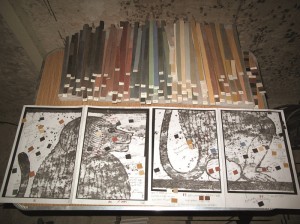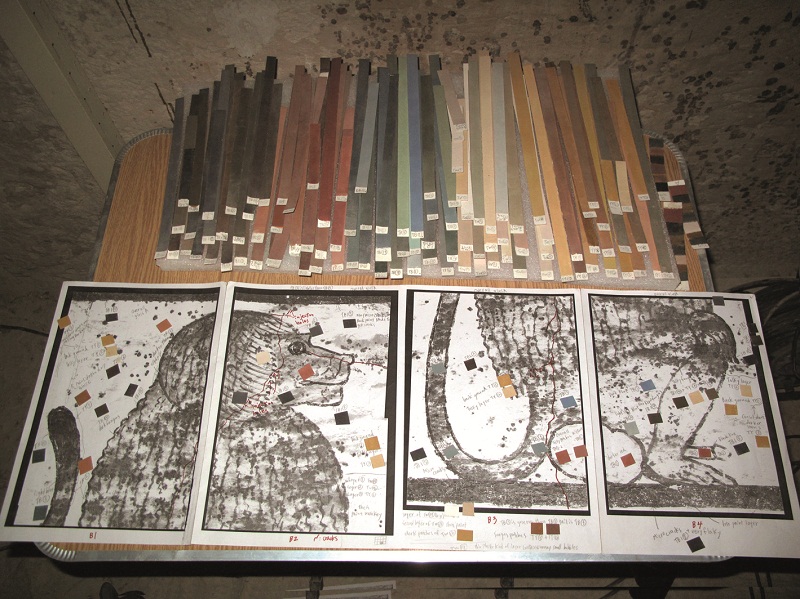
Gregoire Dupond/Factum Arte
Ninety years ago Howard Carter made a discovery that has enthralled the world for close to a century. The historical find was of course the tomb of Tutankhamen, one of the only pharaonic tombs to have been found with all its treasures intact. As Carter and his associates slowly unearthed the doors to the tomb and entered the chambers, people the world over marvelled at the astounding amounts of treasure that was found buried with the boy pharaoh.
Ever since then the treasures of Tutankhamen have drawn visitors to different museums that display part of the collection. A painstakingly made collection of replicas has been touring the world the past few years, giving those that do not have the opportunity to visit the Egyptian museum the chance to feast their eyes on the jewellery and artefacts, and of course the massive, iconic golden mask that shows every detail of Tutankhamen’s face.
While some object to replicas and dismiss them as fakes, others believe that by creating perfect replicas fragile monuments can be preserved while still offering the public a chance to marvel at the wonders of yesteryear. The latter theory lies at the heart of a project that created in an exact replica of the tomb of Tutankhamen, which arrived in Cairo this week.
The Spanish Factum Arte workshop worked closely with the Society of Friends of the Royal Tombs of Egypt (based in Switzerland) and the Supreme Council of Antiquities to develop the technology and practical implementation to create an exact copy of the famous tomb, which is under considerable threat of damage from the vast amount of visitors it attracts. The facsimile is a gift from the Factum Foundation, the Society of Friends of the Royal Tombs of Egypt and the University of Basel to the Egyptian people.
The millennia old tombs in the Valley of the Kings in Luxor were designed to withstand time but not thousands of visitors. A visit to the tombs is awe inspiring, as you gaze upon the drawings made in vibrant colours on the walls of tombs, buried deep beneath the desert floor, it is hard to imagine that they were drawn 3,000 years ago.
Unfortunately, the decorated plaster on the walls is not resistant to the dust the visitors bring into the tombs, or the humidity they create with every breath. Several tombs have been closed to the public to avoid any further damage while others are open on a rotation basis, in a bid to strike a balance between preserving the past and sharing it with the tourists that have never lost their fascination with the world of the pharaohs.
In 1988 the Supreme Council of Antiquities, working closely with the Society of Friends of the Royal Tombs of Egypt, embarked on a policy to create exact copies of some of the major tombs in the Valley of the Kings, to open to the public an alternative and new approach to sustainable tourism. Three tombs were identified for recreation and three years ago the Factum Arte workshop commenced the highly advanced data collection that would be the foundation of an exact reproduction of the tomb of Tutankhamen.
It is a unique project and never has an archaeological site of significance of this size been reproduced so exactly. Special software was developed and light and laser scanning techniques were used to create digital data of every single detail of the tomb, the sarcophagus, its lid and the missing piece of the south wall that was removed by Carter in order to empty the tomb of its treasures.
The construction of the facsimile involved the development of every possible shade of colour used in the tomb decorations, designing a huge flatbed printer, and an enormous amount of man-hours; from start to finish the project took over three years to complete and earlier this week the tomb was presented to Egypt, during the EU Task Force conference about Tourism and Flexible Investment.
After the conference the tomb was set to go to a site chosen by the Supreme Council of Antiquities in 2010, near the entrance of the Valley of the Kings and close to Howard Carter’s house. This week the current minister of Antiquities indicated that instead of placing the replica of Tutankhamen’s tomb close to where the real one is situated it may be preferable to install it in a major tourist resort like Hurghada or Sharm El Sheikh to attract tourists who may want to follow up exploring the tomb with a visit to Luxor.
“It is not a bad idea to display the replica as a large advertisement for the timeless sites in Luxor, but of course the preference of the people that helped fund and build the painstakingly correctly made tomb is for the originally planned site close to the Valley of the Kings,” Nigel Hetherington, archaeologist and consultant to the project said. “However, the final decision will be made by the minister of Antiquities.”
It is not the first time that so called conservation archaeology has included the construction of replicas, famous examples include prehistoric cave paintings in western Europe and Veronese’s The Wedding at Cana painting, an exact copy of which has been installed in the very place it was designed to be displayed.
“When the replica of the cave was placed close to the real site people wondered if visitors would pay it a visit when the original one was so close at hand,” Hetherington said. “People care that history is preserved though and millions of them chose to safely marvel at the beauty of the cave in the facsimile rather than cause more damage to the original one.”
Hetherington highlighted another interesting side of the project, “another unique part of this project is that it is set up to be a true partnership; it is not a bunch of foreigners coming to Egypt and telling people what to do. The data that has been accumulated is part of the gift of the tomb and will prove to be of great value to anyone studying it.”
The gift of the tomb and all that comes with it is designed to do more than just offer a replica of Tutankhamen’s last resting place. Three major objectives have been identified by the partners and they include the promotion of sustainable tourism and to use it as a positive drive to preserve the country’s heritage; the transfer of knowledge and the creation of a state of the art workshops on Luxor’s west bank to continue with the mapping and creation of exact replicas of the tombs of Seti I and Queen Nefertari; and to create highly skilled and long term employment opportunities in Luxor.
Wherever the tomb of Tutankhamen ends up in Egypt, it may very well be the start of a new way to preserve the nation’s priceless archaeological treasures.




